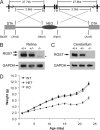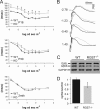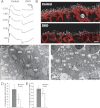Defective retinal depolarizing bipolar cells in regulators of G protein signaling (RGS) 7 and 11 double null mice
- PMID: 22371490
- PMCID: PMC3340290
- DOI: 10.1074/jbc.M112.345751
Defective retinal depolarizing bipolar cells in regulators of G protein signaling (RGS) 7 and 11 double null mice
Abstract
Two members of the R7 subfamily of regulators of G protein signaling, RGS7 and RGS11, are present at dendritic tips of retinal depolarizing bipolar cells (DBCs). Their involvement in the mGluR6/Gα(o)/TRPM1 pathway that mediates DBC light responses has been implicated. However, previous genetic studies employed an RGS7 mutant mouse that is hypomorphic, and hence the exact role of RGS7 in DBCs remains unclear. We have made a true RGS7-null mouse line with exons 6-8 deleted. The RGS7(-/-) mouse is viable and fertile but smaller in body size. Electroretinogram (ERG) b-wave implicit time in young RGS7(-/-) mice is prolonged at eye opening, but the phenotype disappears at 2 months of age. Expression levels of RGS6 and RGS11 are unchanged in RGS7(-/-) retina, but the Gβ5S level is significantly reduced. By characterizing a complete RGS7 and RGS11 double knock-out (711dKO) mouse line, we found that Gβ5S expression in the retinal outer plexiform layer is eliminated, as is the ERG b-wave. Ultrastructural defects akin to those of Gβ5(-/-) mice are evident in 711dKO mice. In retinas of mice lacking RGS6, RGS7, and RGS11, Gβ5S is undetectable, whereas levels of the photoreceptor-specific Gβ5L remain unchanged. Whereas RGS6 alone sustains a significant amount of Gβ5S expression in retina, the DBC-related defects in Gβ5(-/-) mice are caused solely by a combined loss of RGS7 and RGS11. Our data support the notion that the role of Gβ5 in the retina, and likely in the entire nervous system, is mediated exclusively by R7 RGS proteins.
Figures





Similar articles
-
Functional redundancy of R7 RGS proteins in ON-bipolar cell dendrites.Invest Ophthalmol Vis Sci. 2010 Feb;51(2):686-93. doi: 10.1167/iovs.09-4084. Epub 2009 Sep 24. Invest Ophthalmol Vis Sci. 2010. PMID: 19797210 Free PMC article.
-
Two R7 regulator of G-protein signaling proteins shape retinal bipolar cell signaling.J Neurosci. 2009 Jun 17;29(24):7753-65. doi: 10.1523/JNEUROSCI.1794-09.2009. J Neurosci. 2009. PMID: 19535587 Free PMC article.
-
GPR179 is required for high sensitivity of the mGluR6 signaling cascade in depolarizing bipolar cells.J Neurosci. 2014 Apr 30;34(18):6334-43. doi: 10.1523/JNEUROSCI.4044-13.2014. J Neurosci. 2014. PMID: 24790204 Free PMC article.
-
RGS Protein Regulation of Phototransduction.Prog Mol Biol Transl Sci. 2015;133:31-45. doi: 10.1016/bs.pmbts.2015.02.004. Epub 2015 Apr 16. Prog Mol Biol Transl Sci. 2015. PMID: 26123301 Free PMC article. Review.
-
R9AP and R7BP: traffic cops for the RGS7 family in phototransduction and neuronal GPCR signaling.Trends Pharmacol Sci. 2009 Jan;30(1):17-24. doi: 10.1016/j.tips.2008.10.002. Epub 2008 Nov 29. Trends Pharmacol Sci. 2009. PMID: 19042037 Free PMC article. Review.
Cited by
-
Lack of mGluR6-related cascade elements leads to retrograde trans-synaptic effects on rod photoreceptor synapses via matrix-associated proteins.Eur J Neurosci. 2016 Jun;43(11):1509-22. doi: 10.1111/ejn.13243. Epub 2016 May 10. Eur J Neurosci. 2016. PMID: 27037829 Free PMC article.
-
LRRTM4 is a member of the transsynaptic complex between rod photoreceptors and bipolar cells.J Comp Neurol. 2021 Jan;529(1):221-233. doi: 10.1002/cne.24944. Epub 2020 Jun 27. J Comp Neurol. 2021. PMID: 32390181 Free PMC article.
-
Gβ3 is required for normal light ON responses and synaptic maintenance.J Neurosci. 2012 Aug 15;32(33):11343-55. doi: 10.1523/JNEUROSCI.1436-12.2012. J Neurosci. 2012. PMID: 22895717 Free PMC article.
-
Differential epitope masking reveals synapse-specific complexes of TRPM1.Vis Neurosci. 2018 Jan;35:E001. doi: 10.1017/S0952523817000360. Vis Neurosci. 2018. PMID: 29370879 Free PMC article.
-
Sequence analysis of chromosome 1 revealed different selection patterns between Chinese wild mice and laboratory strains.Mol Genet Genomics. 2017 Oct;292(5):1111-1121. doi: 10.1007/s00438-017-1335-z. Epub 2017 Jun 19. Mol Genet Genomics. 2017. PMID: 28631230
References
-
- Ross E. M., Wilkie T. M. (2000) GTPase-activating proteins for heterotrimeric G proteins: regulators of G protein signaling (RGS) and RGS-like proteins. Annu. Rev. Biochem. 69, 795–827 - PubMed
-
- Snow B. E., Krumins A. M., Brothers G. M., Lee S. F., Wall M. A., Chung S., Mangion J., Arya S., Gilman A. G., Siderovski D. P. (1998) A G protein γ subunit-like domain shared between RGS11 and other RGS proteins specifies binding to Gβ5 subunits. Proc. Natl. Acad. Sci. U.S.A. 95, 13307–13312 - PMC - PubMed
Publication types
MeSH terms
Substances
Grants and funding
LinkOut - more resources
Full Text Sources
Molecular Biology Databases

